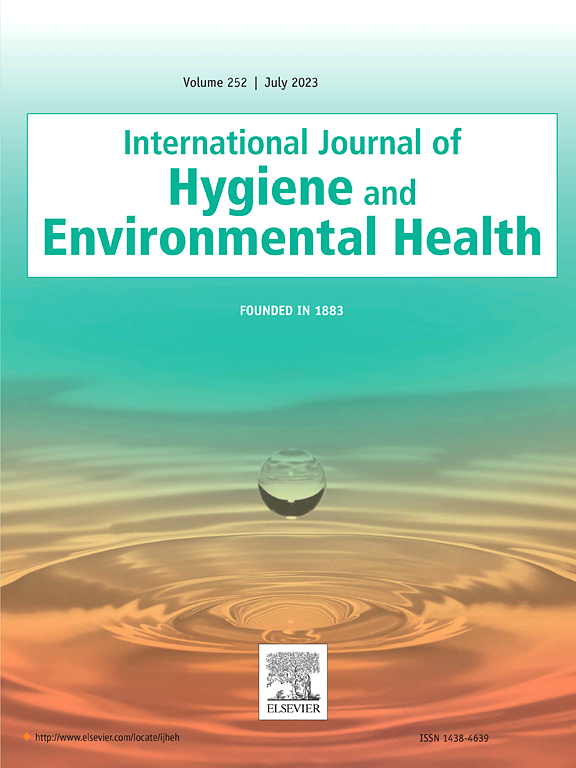特定 PM2.5 化学成分和臭氧暴露与华中地区接受辅助生殖技术治疗的妇女妊娠结局的关系。
IF 4.5
2区 医学
Q1 INFECTIOUS DISEASES
International journal of hygiene and environmental health
Pub Date : 2024-10-07
DOI:10.1016/j.ijheh.2024.114474
引用次数: 0
摘要
空气污染物暴露与辅助生殖技术(ART)妊娠结局的关系不一,而细颗粒物(PM2.5)和臭氧(O3)中特定成分的影响尚不十分清楚。我们进行了一项回顾性纵向研究,以探讨在接受 ART 治疗的妇女中,PM2.5 成分和 O3 暴露与三种 ART 结果之间的关系。暴露窗口被划分为五个时期,分别对应卵巢刺激周期和卵母细胞提取过程。应用广义线性混合模型(GLMM)探讨了 PM2.5 成分、O3、归一化植被指数(NDVI)暴露与三种 ART 结果之间的关系。PM2.5成分的综合效应通过量化g(qg)计算进行评估。我们还探讨了不同协变量的调节作用。PM2.5 暴露水平的升高(OR = 0.915,95% CI:0.859,0.974)及其成分(BC:0.905,95% CI:0.840,0.975;OM:0.910,95% CI:0.848,0.976;NO3-:0.909,95% CI:0.850,0.972,SO42-:0.905, 95% CI: 0.846, 0.968, and NH4+: 0.902, 95% CI: 0.842, 0.966)与取卵前一年(第 1 期)的活产几率比(OR)降低具有统计学意义。同样,在第 2 期(取卵前 85 天)、第 3 期(取卵前 30 天)、第 4 期(取卵至胚胎移植)和第 5 期(胚胎移植至 hCG 检测),每增加一个四分位数间距(IQR)的 O3 暴露量,都与活产几率下降显著相关。特别是,接受过新鲜胚胎移植周期和两次卵裂期胚胎移植、年龄小于 30 岁的参与者对颗粒物的易感性更高。这项研究的结果表明,PM2.5 成分和 O3 暴露可能会对 ART 的结果产生不利影响,这凸显了确定各种空气污染物关键暴露期的重要性,以及对颗粒物进行细致管理的必要性。本文章由计算机程序翻译,如有差异,请以英文原文为准。
Association of specific PM2.5 chemical constituents and ozone exposure with pregnancy outcomes in women undergoing assisted reproductive technology treatment in central China
The associations of air pollutants exposure with assisted reproductive technology (ART) pregnancy outcomes are mixed, and the effects of specific components of fine particulate matter (PM2.5) and ozone (O3) are not well understood. We conducted a retrospective longitudinal study to explore the association of PM2.5 constituents and O3 exposure with three ART outcomes among women undergoing ART treatment. The exposure window was segmented into five periods corresponding to the cycle of ovarian stimulation and oocyte retrieval procedure. Generalized linear mixed model (GLMM) was applied to explore the relationships between PM2.5 constituents, O3, Normalized Vegetation Index (NDVI) exposure and three ART outcomes. The combined effect of PM2.5 constituents was evaluated by the quantile g (qg)-computation. We also explored the modifying effect of different covariate. Elevated exposure level of PM2.5 (OR = 0.915, 95% CI: 0.859, 0.974) and its constituents (BC: 0.905, 95% CI: 0.840, 0.975; OM: 0.910, 95% CI: 0.848, 0.976; NO3−: 0.909, 95% CI: 0.850, 0.972, SO42−: 0.905, 95% CI: 0.846, 0.968, and NH4+: 0.902, 95% CI: 0.842, 0.966) exposure throughout the year before oocyte retrieval (period 1) was correlated with a reduced odds ratio (OR) of live birth with statistical significance. Similarly, for each interquartile range (IQR) increase in O3 exposure during periods 2 (85 days prior to oocyte retrieval), 3 (30 days prior to oocyte retrieval), 4 (oocyte retrieval to embryo transfer) and 5 (embryo transfer to hCG test) was significantly related to a decreased OR of live birth. Especially, participants who underwent fresh embryo transfer cycles and received two cleavage-stage embryo transfer, and were younger than 30 years old, showed a higher susceptibility to particulate matter. Findings from this study suggest that PM2.5 constituents and O3 exposure may have adverse effects on the ART outcomes, highlighting the importance of identifying critical exposure periods for various air pollutants and the need for meticulous management of particulate matter.
求助全文
通过发布文献求助,成功后即可免费获取论文全文。
去求助
来源期刊
CiteScore
11.50
自引率
5.00%
发文量
151
审稿时长
22 days
期刊介绍:
The International Journal of Hygiene and Environmental Health serves as a multidisciplinary forum for original reports on exposure assessment and the reactions to and consequences of human exposure to the biological, chemical, and physical environment. Research reports, short communications, reviews, scientific comments, technical notes, and editorials will be peer-reviewed before acceptance for publication. Priority will be given to articles on epidemiological aspects of environmental toxicology, health risk assessments, susceptible (sub) populations, sanitation and clean water, human biomonitoring, environmental medicine, and public health aspects of exposure-related outcomes.

 求助内容:
求助内容: 应助结果提醒方式:
应助结果提醒方式:


